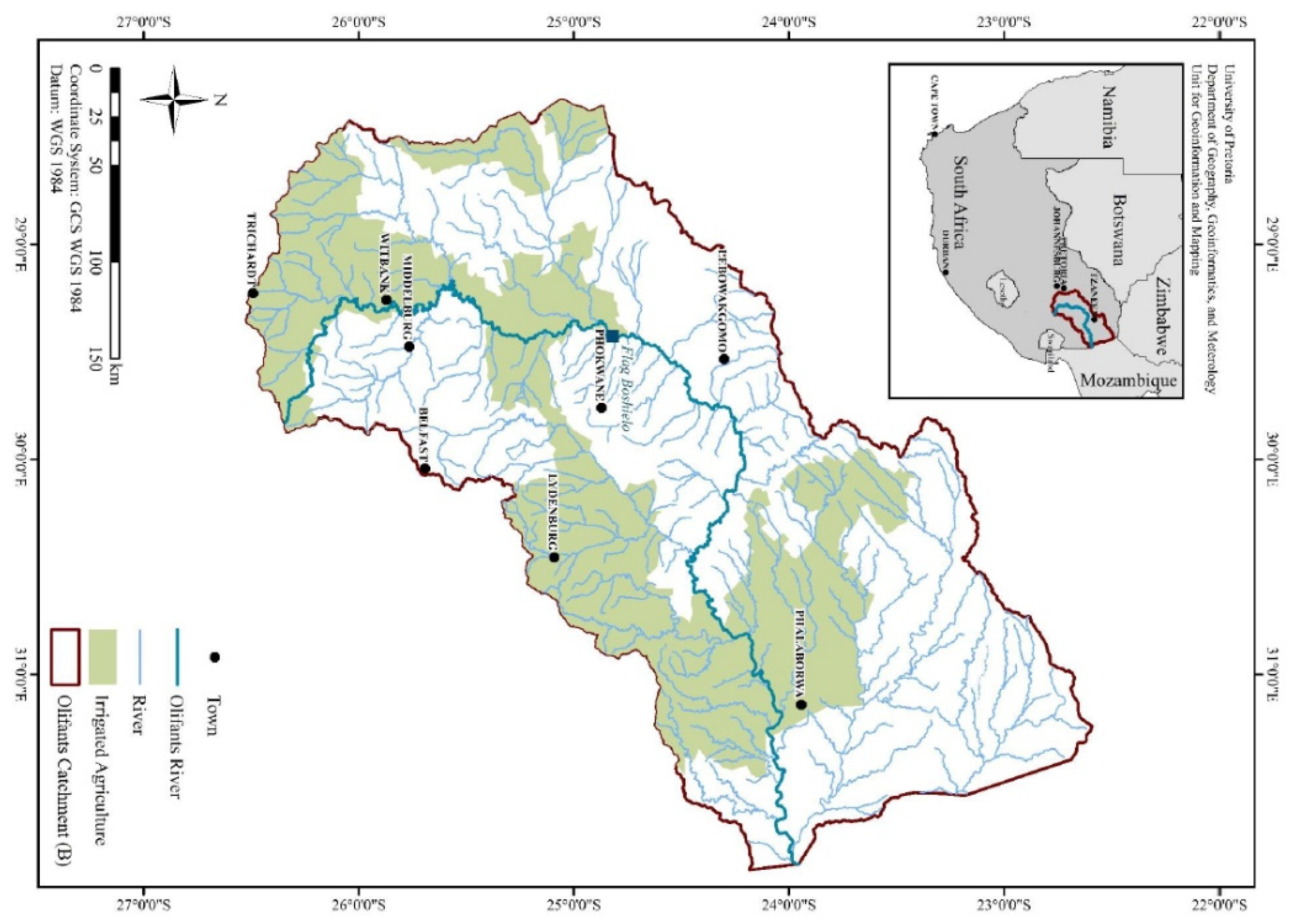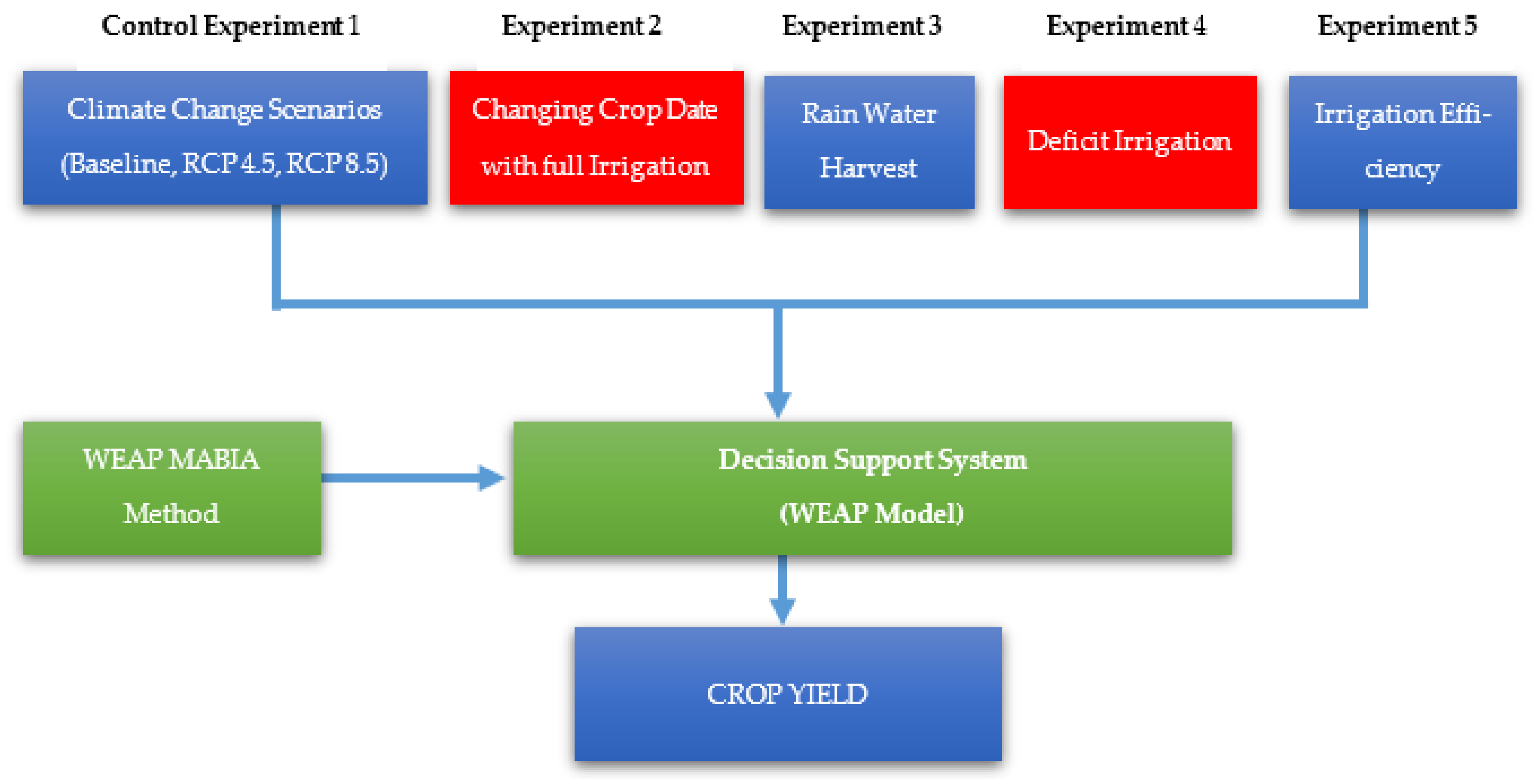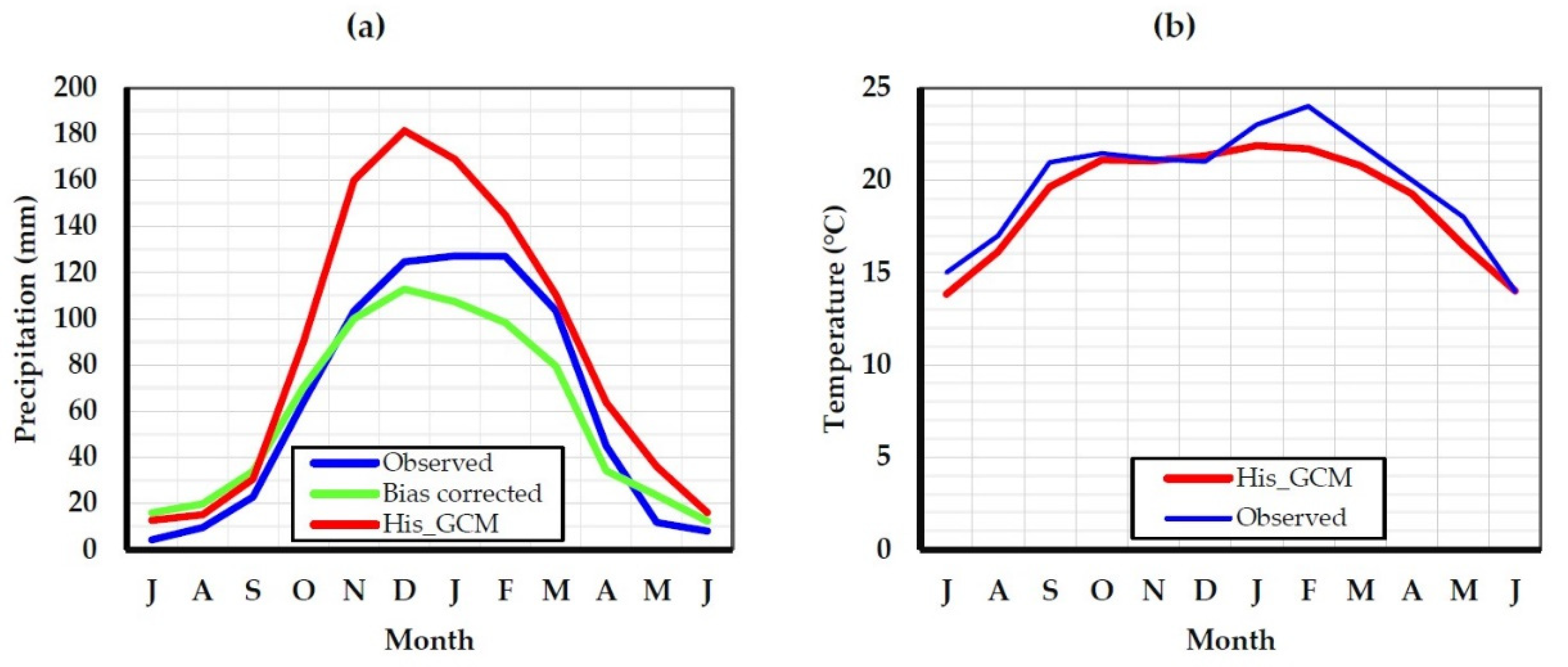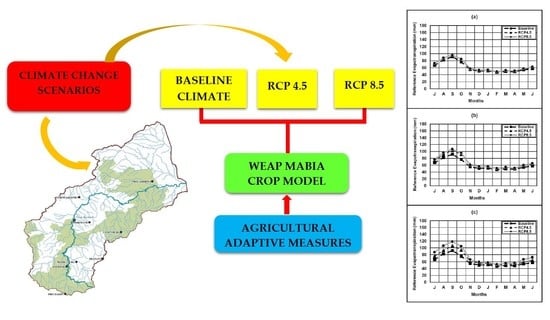2.1. Study Area and Data
The Olifants River Basin is one of the nineteen water management areas in South Africa. It is a principal sub-catchment of the Limpopo River. It originates in the north of South Africa in the province of Mpumalanga and flows northeast through the northern province before joining in Mozambique and emptying into the Indian Ocean (
Figure 1). An estimated 3.2 million people live within the catchment area with two-thirds of this population living in the rural community [
26]. The Olifants River Basin is recognized as one of the most important basins in South Africa as it contributes largely to the country’s economic hub, with an annual contribution of six percent to the Gross Domestic Product arising from agricultural, mining, and industrial activities [
27]. The catchment consists of both large and medium-scale agricultural farms that consume a lot of water for irrigation (540 Mm
3 per year) with approximately 130,000 ha irrigated (i.e., 11% of the total cultivated area in the catchment), primarily in the commercial farming sector. The water used for irrigation is obtained from both dams and groundwater in the catchment [
28]. Precipitation in the catchment occurs during the summer months from October to April, with average annual rainfall ranging between 500 mm to 800 mm in most parts of the catchment and surpasses 1000 mm along the escarpment which separates the Highveld from the Lowveld. Evaporation varies across the catchment with high levels occurring in the north and west, and lower levels of evaporation recorded in the southeast. Elevations range from 300 m to over 2300 m above sea level, which explains the relatively cool winter and annual wide-range of temperature variations of −4 to 35 °C [
29]. Runoff from the catchment reflects the temporal and spatial distribution of the rainfall with the greatest volumes occurring in the south and along the escarpment. The average annual runoff from the catchment is 37.5 mm (i.e., 6% of the average annual rainfall), which equates to 2040 million cubic meters (Mm
3). However, there is considerable inter-annual variation and consecutive years where the flow is below the mean annual discharge [
30].
This study uses climate simulated data (daily rainfall, minimum, and maximum temperature, average relative humidity, 2 m wind speed, and solar radiation) from the Coordinated Regional Climate Downscaling Experiment (CORDEX) database. The data were obtained from
http://cordexesg.dmi.dk/esgf-web-fe/. The output from CORDEX RCMs are quality controlled and can be used according to the terms of use (
http://wcrp-cordex.ipsl.jussieu.fr/). It should be noted that all Coordinated Regional Downscaling Experiment-Regional Climate Models (CORDEX RCMs) are set to 0.44° by 0.44°spatial resolutions, which corresponds to 50 km by 50 km. The area-weighted average method [
31] was used to calculate the average climate variables from the CORDEX RCMs over the entire Olifants River catchment (latitude 24° and 26° and longitude 29° and 32°). Daily climate variables listed above were obtained from a single RCM driven by six Global Climate Models (GCMs) namely, Commonwealth Scientific and Industrial (CSIRO), National Centre for Meteorological Research (CNRM), Canadian Centre for Modelling and Analysis (CCMA), Institut Pierre Simon Laplace (IPSL), Model for Interdisciplinary Research on Climate (MIROC), and Max Planck institute for Meteorological Earth System Model (MPI-ESM) for a period of 30 years (1976–2005). Two projected climate change scenarios, representative concentration pathways (RCP 4.5 and 8.5) were used. The former represents an intermediate stabilization of radioactive forcing by 2100, without surpassing 4.5 W/m
2 (~650 ppm CO
2), which constitutes a high mitigation scenario [
32]. Whilst the RCP 8.5 scenario assumes that the radioactive forcing pathway reaches above 8.5 W/m
2 (~1370 ppm CO
2) by 2100 [
33].
Using CORDEX-RCM climate change data, three time periods 2010–2039, 2040–2069, 2070–2099 were considered in this study to project future climate for both greenhouse gas concentration scenarios. These time periods were then compared to the baseline period, 1976–2005. CORDEX climate variables were biased corrected using a linear scaling bias correction method. Observed climate variables obtained from the South African weather service were used to bias correct the current and projected CORDEX climate data [
34]. It was necessary to bias correct the simulated climate data in order to compensate for any over or underestimation of the downscaled variables. The linear scaling bias correction is based on the average difference between daily observed time series data. These differences were then applied to the simulated climate data to obtain bias-corrected variables [
34]. The biased-corrected climate variables were then integrated into a decision support system (Water Evaluation and Planning) model to evaluate current and future crop yield and adaptation scenarios using the WEAP-MABIA method.
The WEAP-MABIA model used in this study has a soil profile library functionality that provides typical values for water content at saturation, field capacity, wilting point, and the available water capacity for 12 textural classes. It uses a pedotransfer function to estimate the average soil water capacity. In this study, we assumed scenarios of three textural classes of soil to evaluate its impacts on crop yield under current climate conditions. The three textural classes of soil were (S1-sandy loam, S2-loamy sand, and S3-Sandy clay loam) presented in
Table 1.
Crop parameters were also obtained from the crop library functionality within the WEAP-MABIA. The “Crop Library” provides the required parameters for over 100 crops, some with multiple entries for different climates or regions of the world. The end-user can add, edit, remove, copy, export, import, or search the “Crop Library” for a particular crop. This study selected four crops namely: maize, soya beans, dry beans, and sunflower from the crop library using the crop scheduling wizard. The crop parameter used in this study is presented in
Table 2.
The lengths of growth stages (Lini, Ldev, Lmid, Llate) were computed according to the FAO-56 method as a function of vegetation cover (fc). The initial stage (Lini) runs from the sowing date to when the fc reaches a value of 0.1, the development stage (Ldev) runs from a fc of 0.1 to full vegetation cover (fc of 0.9). The mid-season stage (Lmid) runs from the end of the development stage until canopy cover (fc) drops back to the same value it had at the end of the development stage and the beginning of the mid-season period (fc = 0.9). The late-season stage (Llate) runs from the end of the mid-season stage until the end of the growing season.
The basal crop coefficient (Kcb) is defined as the ratio of the crop evapotranspiration ETc over the reference evapotranspiration ETref when the soil surface is dry but transpiration is occurring at a potential rate. Therefore, Kcb represents primarily the transpiration component of ETc. The Kcb coefficient serves as a lumped parameter for the physical and physiological differences between crops. Variation in Kcb between the growth stages is mainly dependent on how the crop canopy develops. The values given in the “crop library” represent a standard climate having mean daily minimum relative humidity (RHmin) equal to 45% and mean daily wind speed measured at 2 m (u2) equal to 2 m s−1.
The depletion factor (p) is the fraction of the total available water (TAW) that can be depleted from the root zone before moisture stress occurs. Different values can be defined to express the variation of the crop sensitivity to water shortage over the different crop stages.
The yield response factor (Ky) is a factor that describes the reduction in relative yield according to the reduction in the crop evapotranspiration (ETc) caused by soil water shortage. Ky values are crop-specific and may vary over the growing season. The values for Ky are given for the individual growth periods as well as for the complete growing season.
The rooting depth for annual crops has three growth stages. The rooting depth is held constant at the minimum depth (Zr min) throughout the initial crop growth stage. The root zone increases linearly to a maximum depth (Zr max) throughout the vegetative growth and development stages
The maximum root depth is attained at the beginning of the mid-season stage (peak growth) and is maintained throughout the mid and late season stage [
35].
2.2. Description of WEAP Model
The water evaluation and planning model developed by the Stockholm Environment Institute (SEI) is a decision support system (DSS) used for the integration of water resources management and planning. It is easy to use for water planning and scenario assessment. WEAP simulates water balance for water demand, supply, and storage on a monthly basis and it allows the assessment of water resource management policies between different sectors (agriculture, industry, tourism). It can be applied at a catchment level as well as other more complex levels such as regional and country levels [
36].
Within the WEAP model, different agricultural catchment calculation methods can be used. In this study, we used the WEAP-MABIA method version 1.0.1 [
35] to simulate crop water requirement, crop yield as well as agricultural management plans under different climate conditions. The selection of this method was based on the fact that it has been applied by scientists, engineers, and resource managers to simulate runoffs, infiltration, and percolation processes resulting from natural rainfall, irrigation scheduling, and crop yield reduction [
35,
37,
38,
39]. The WEAP-MABIA method calculate evapotranspiration using the ‘dual’ crop coefficient kc method (Kc = Ke + Ks Kcb), as described in Allen et al. [
40], whereby the Kc value is divided into a ‘basal’ crop coefficient, Kcb, and a separate component, with Ke, representing evaporation from a shallow soil surface layer. The basal crop coefficient represents actual ET conditions when the soil surface is dry but sufficient root zone moisture is present to support full transpiration.
The reference evapotranspiration (ET
0) for the Olifants catchment was calculated using the modified Penman-Monteith equation recommended by Allen et al. [
40]. The equation utilizes some assumed constant parameters for a clipped grass reference crop. It was assumed that the definition for the reference crop was a hypothetical reference crop with a crop height of 0.12 m, a fixed surface resistance of 70 s m
−1 and an albedo value (i.e., a portion of light reflected by the leaf surface) of 0.23 [
41]. The equation used for calculating ET
0 is given below:
where
RN is the net radiation at the crop surface,
G is the soil heat flux density,
T represents the mean daily air temperature at 2 m height,
U2 is the wind speed at 2 m height,
es is the saturation vapor pressure,
ea is the actual vapor pressure, (
es–ea) represents the vapor pressure deficit of the air, Δ is the slope vapor pressure curve, and γ represents the psychometric constant.
The following climate parameters such as daily temperature (minimum and maximum), average relative humidity, 2-m wind speed, and solar radiation were used to estimate the current and projected reference crop evapotranspiration.
The performance of the WEAP-MABIA was verified by calibrating and validating observed crop yield data for Mpumalanga province where the Olifants catchment is situated, as there was no recorded crop data for the catchment. The data was obtained from the Department of Agriculture, Fisheries, and Forestry (DAFF). The efficiency of the model performance was determined by comparing the observed against the simulated crop yield using two verification statistics such as Coefficient of Determination (
R2) and Nash-Sutcliffe Efficiency (NSE). The values of
R2 ranges between 0–1, values higher than 0.5 are considered acceptable. While NSE ranges between −∞ and 1.0, where NSE = 1 indicates a perfect match of simulated and observed yield. An efficiency of 0 shows that the model prediction is as accurate as the mean of the observed data, while an efficiency less than 0 shows that the observed mean is a better predictor than the model. For more detail on the procedure and statistical equation used for the calibration and validation of the model, readers should consult Olabanji et al. [
29]. We calibrated and validated the WEAP-MABIA crop model using observed crop yield data for the period of 1995–2000 for calibration and 2001–2004 for validation. The results presented in
Table 3 show that the simulated crop yield perfectly agrees with the observed yield with NSE ranging between 0.97 to 0.99 during calibration and 0.87 to 0.96 during validation. The coefficient of determination (
R2) ranged between 0.98 to 1.0 for calibration and 0.95 to 0.98 during the validation process. The agreement between the simulated and observed crop yield indicates the capability of the crop model to simulate future crop yields.












